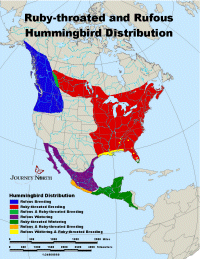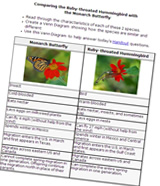| Please
Report Your Sightings! |
Rufous hummingbirds pushed further east this week into eastern Washington and Idaho. The warmer than average temperatures this spring have offered migrating hummingbirds nectar and bugs to fuel up along the way. Is this pushing the migration faster this year? Compare two species and think how their differences and similarities affect their migrations. Earth Day is a good time to think about how to best care for the earth and its creatures, including hummingbirds!
Today's Report Includes:
- Highlights, Maps, and Questions
- Explore: Comparing Two Species
- Journal: How Can You Help Hummingbirds?
- Getting Started: This Week's Hummingbird Resources
Highlights:
Hummers
Pushing East!
Rufous hummers were pushing eastward this week and crossed the Washington
border into northern Idaho. It's fun to imagine the migration from watching
the map as citizen scientists report their first sightings this spring.
- In Potlatch, Idaho citizen scientist reported, "The male Rufous showed up on our feeder this morning (4/19), about 6:15 a.m. The earliest we have seen them is 4/16."
|
Rubythroats have migrated a LONG way since the first of April! The warmer than average temperatures this spring have offered migrating hummingbirds nectar and bugs to fuel up along the way. Haven't seen one yet, but your neighbors have? Don't give up—one hummer spotter from Milan, Indiana waited 15 days from first putting their feeder up to see a ruby. "I will celebrate today!" they exclaimed after their first sighting.
Are you keeping track on your prediction chart? This week we can add Minnesota and Wisconsin to the chart.
 Distribution Map |
||
| Rufous
|
Ruby-throated
|
|
| Handouts:
Today's Hummingbird Map Questions Rufous Questions Rubythroat Questions |
||
Ruby-throated hummingbirds are not the only animals who are migrating across eastern North America right now, eating nectar as they travel. Can you think of another animal that eats nectar to fuel their migration? Did you think monarchs? Right!
Let's compare these 2 species. Study the characteristics of each animal and then create a Venn Diagram showing similarities and differences.
- Now, use
your Venn Diagram and this week's
map handout to dig deeper.
Earth Day is Thursday, April 22. It's a time to think about how to best care for the earth and its creatures. Think about what you know about hummingbirds. Then use your Hummingbird Journal to do this:
- List some ways that human activities might put hummingbirds at risk.
- List 3 ways you might be able to help hummingbirds and their habitat.
When you're done, learn more!
- How to Help Hummingbirds and Their Habitats
|
The Next Hummingbird Migration Update Will Be Posted on April 28, 2010.








